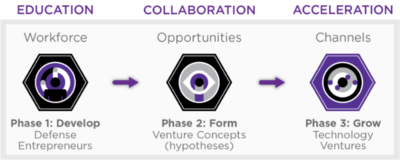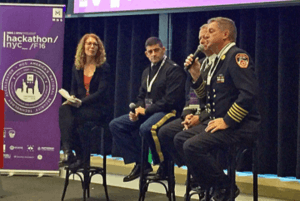MD5 National Security Technology Accelerator

MD5 or MD5 National Security Technology Accelerator is a public-private partnership between the United States Department of Defense (DoD) and a network of national research universities that seeks to reinvigorate civil-military technology collaboration. As opposed to making investments in specific technologies, government research and development programs, or startups, MD5 focuses on human capital innovation - i.e., developing and enabling innovators and human-centered networks to solve national security problems. In support of this mission, MD5 provides tools, training, and access to DoD assets that enable entrepreneurs and intrapreneurs to develop and commercialize high potential products in the national interest.
First conceived in 2015,[1] MD5 launched on October 14, 2016[2] and is part of the Office of the Under Secretary of Defense for Acquisition, Technology, and Logistics, Manufacturing and Industrial Base Policy.[3] MD5 is located at the National Defense University at Fort Lesley J. McNair in Washington, DC. Adam “Jay” Harrison, former founder and managing director of Mav6, is the current director of MD5.
Structure

MD5 consists of a portfolio of programs designed to build a defense innovation workforce that creates ventures relevant to both national security and high-potential civilian applications. These programs are organized in three broad categories: education, collaboration, and acceleration.
MD5’s Education portfolio aims to educate entrepreneurs and intrapreneurs about innovation and national security problems through programs like Hacking for Defense[4] and MD5 Boot Camp.[5] Hacking for Defense, a university-sponsored class that teaches students to work with the DoD to better address national security challenges, was first taught at Stanford University by Steve Blank in the spring of 2016. One team from the pilot class, Capella Space, has secured a combination of DoD and venture capital funding and is scheduled to send the first U.S. commercial synthetic radar satellite into orbit next year.[6] Since then, Hacking for Defense has expanded to UC San Diego,[7] Georgetown University,[8] University of Pittsburgh,[9] James Madison University,[10] and the University of Southern Mississippi,[11] and has been featured in news publications such as The Washington Post[12] and Foreign Policy.[13]

MD5’s Collaboration portfolio connects innovators inside and outside of the Department of Defense to solve national security problems. MD5 Hack is a series of hackathons focusing on areas of shared civil-military interest. MD5’s inaugural hackathon took place on October 14-16, 2016 in Brooklyn, NY, where over 100 hackers worked to solve humanitarian assistance and disaster relief challenges faced by military personnel and first responders.[14] [15] MD5 also sponsors FedTech, an accelerator program that pairs entrepreneurs with technologies from federal labs to conduct customer discovery and business model development.[16] Lastly, MD5 promotes collaborative innovation virtually through an online platform, MD5.net, which includes modules for specific innovation communities, such as Marine Makers.[17]
MD5’s Acceleration portfolio provides funding, prototyping, and infrastructure resources needed to translate high potential concepts into minimum viable products or prototypes. The MD5 Proof of Concept Center (PoCC) at the University of Southern Mississippi provides digital design and manufacturing resources in support of distributed prototyping. The PoCC supports the Commandant of the Marine Corps Innovation Challenges by building hardware prototypes of concepts crowdsourced from the active duty Marine community. Other Acceleration portfolio programs include the Defense Innovation Proving Ground, an effort led by the West Virginia University that furnishes DoD research and development infrastructure to startups developing technologies relevant to national security, and the Deep Tech Studio, an Innovator-in-Residence program at New York University that applies technology from DoD laboratories to real-world defense and commercial applications.
Recognition
MD5 has received recognition from the highest levels of government. General Paul Selva, Vice Chairman of the Joint Chiefs of Staff, has stated, "Through programs like MD5, the defense department will continue to cultivate innovation and creative problem solving as a core leadership competence and expand opportunities to collaborate with our partners in academia and industry to solve our biggest national security challenges."[18] MD5 was also recognized by the White House as one of the top innovation accomplishments of the Obama Administration.[19]
See also
References
- ↑ Harrison, Adam Jay, and Paul Horn. "National Security Technology Accelerator: A Plan for Civil-Military Industry Innovation." 2015.
- ↑ “MD5 – A New Department of Defense National Security Technology Accelerator – Officially Launches with Disaster Relief Hackathon in New York City.” Press Operations - U.S. Department of Defense, October 14, 2016. https://www.defense.gov/News/News-Releases/News-Release-View/Article/974626/md5-a-new-department-of-defense-national-security-technology-accelerator-offici
- ↑ http://www.acq.osd.mil/mibp/programs/industrial-base-assessments/md5.html
- ↑ http://www.h4di.org
- ↑ https://www.md5.net/bootcamp
- ↑ Yoon, Sangwon. “Stanford Class Challenges Students to Pick Defense Over Google.” Bloomberg, November 30, 2016. https://www.bloomberg.com/news/articles/2016-11-30/stanford-class-challenges-students-to-pick-defense-over-google
- ↑ http://jacobsschool.ucsd.edu/hackingfordefense/
- ↑ http://www.hacking4defensegu.com
- ↑ http://www.engineering.pitt.edu/hacking4defense/
- ↑ http://jmuxlabs.org/hacking-4-defense/
- ↑ http://hacking4defense.st.usm.edu/
- ↑ Gregg, Aaron. "These college students invent things for the Pentagon, and maybe find a business." The Washington Post, February 19, 2017. https://www.washingtonpost.com/business/capitalbusiness/these-college-students-invent-things-for-the-pentagon-and-maybe-find-a-business/2017/02/19/558ac8f0-ea25-11e6-80c2-30e57e57e05d_story.html
- ↑ Ricks, Thomas. "A neat new way to attack military problems: ‘Hacking for Defense’." Foreign Policy, January 25, 2017. http://foreignpolicy.com/2017/01/25/a-neat-new-way-to-attack-military-problems-hacking-for-defense/.
- ↑ Wait, Tammy. "MD5 Launches with Disaster Relief Hackathon in NYC." American Security Today, October 15, 2016. https://americansecuritytoday.com/dods-md5-launches-disaster-relief-hackathon-nyc/.
- ↑ https://www.md5.net/hackathonf16
- ↑ http://www.fed-tech.org
- ↑ https://www.md5.net/marinemaker
- ↑ “MD5 – A New Department of Defense National Security Technology Accelerator – Officially Launches with Disaster Relief Hackathon in New York City.” Press Operations - U.S. Department of Defense, October 14, 2016. https://www.defense.gov/News/News-Releases/News-Release-View/Article/974626/md5-a-new-department-of-defense-national-security-technology-accelerator-offici
- ↑ “FACT SHEET: Celebrating President Obama’s Top 10 Actions to Advance Entrepreneurship, and Announcing New Steps to Build on These Successes.” Office of the Press Secretary - The White House, November 30, 2016. https://obamawhitehouse.archives.gov/the-press-office/2016/11/30/fact-sheet-celebrating-president-obamas-top-10-actions-advance